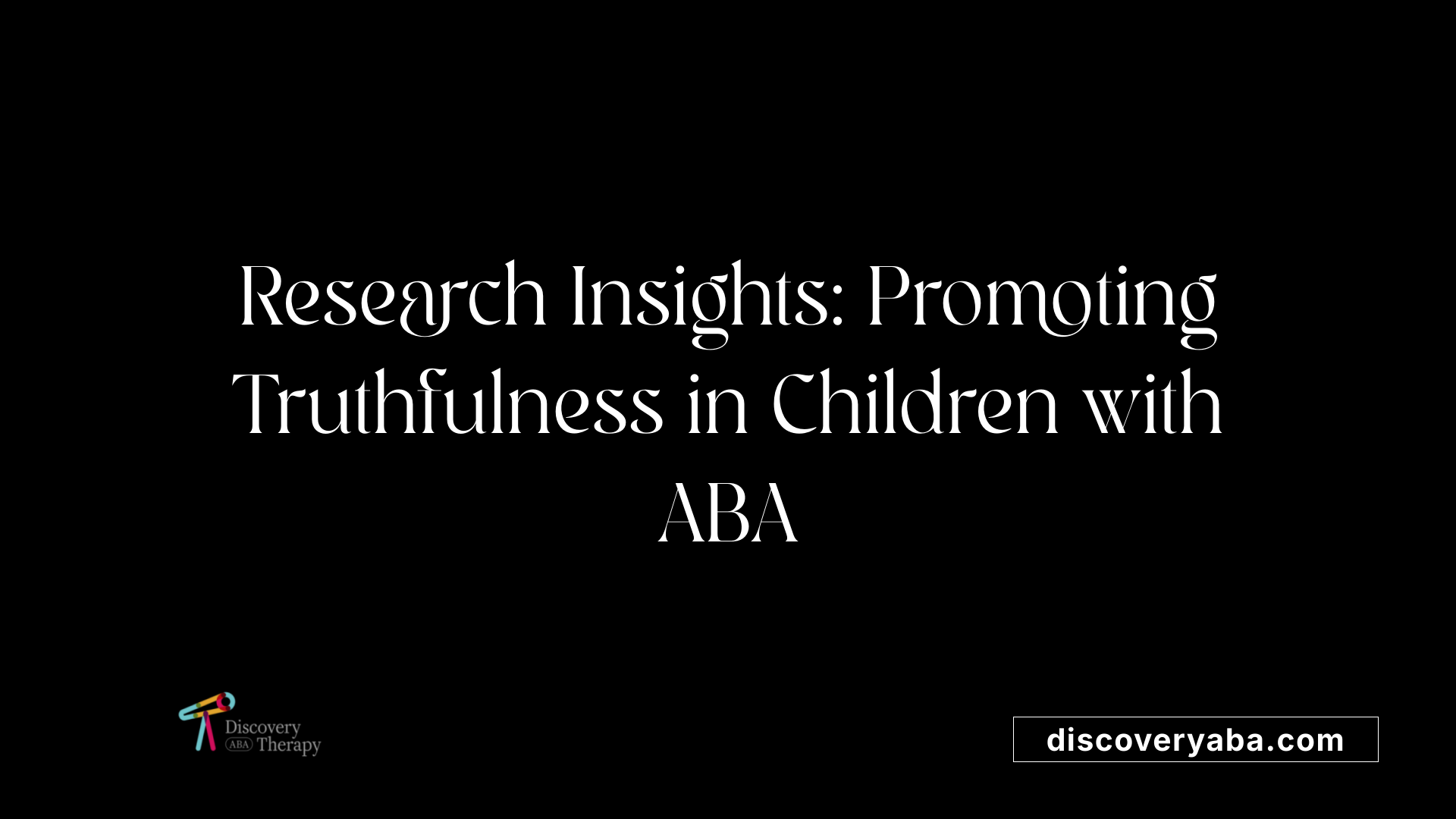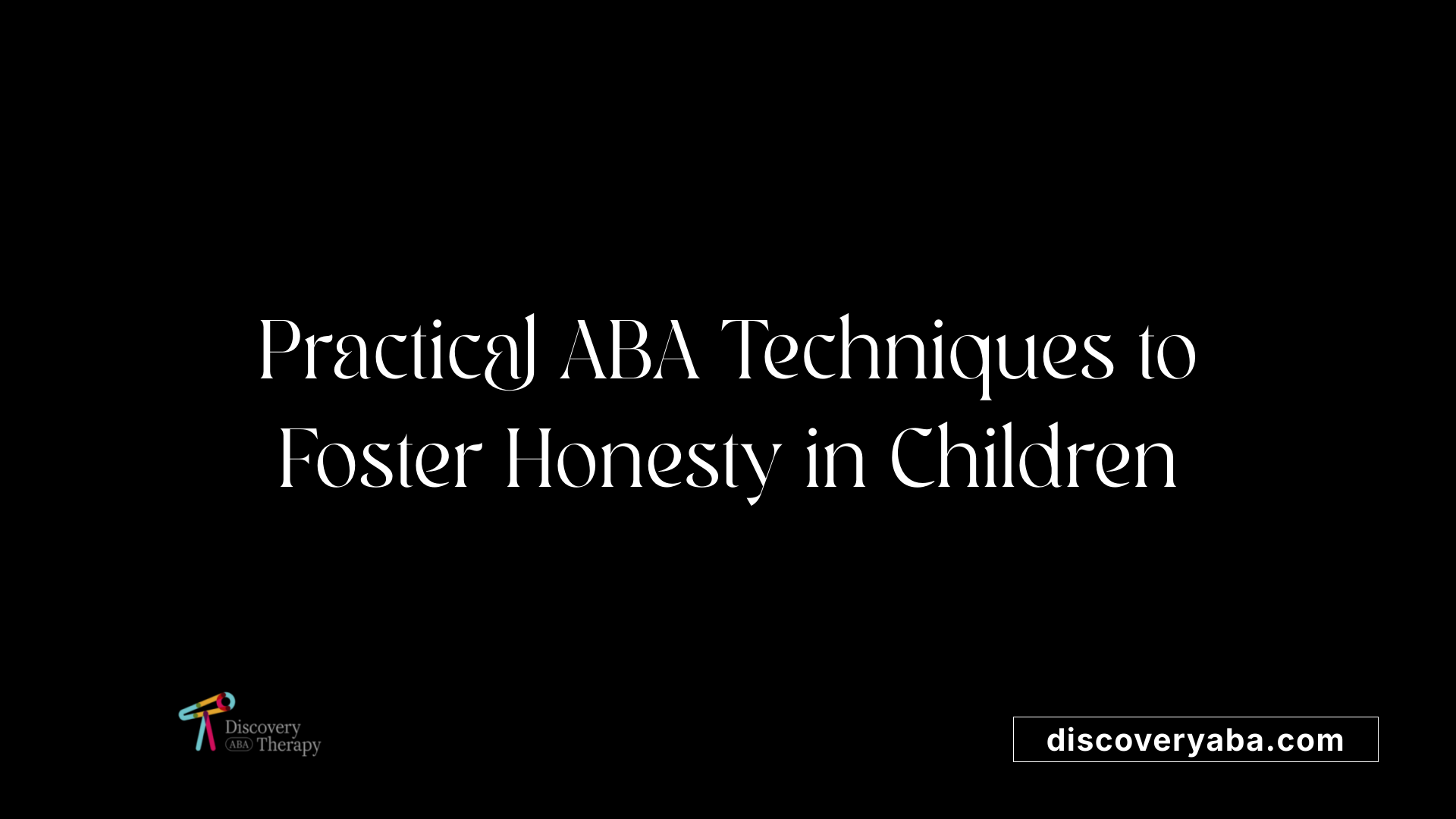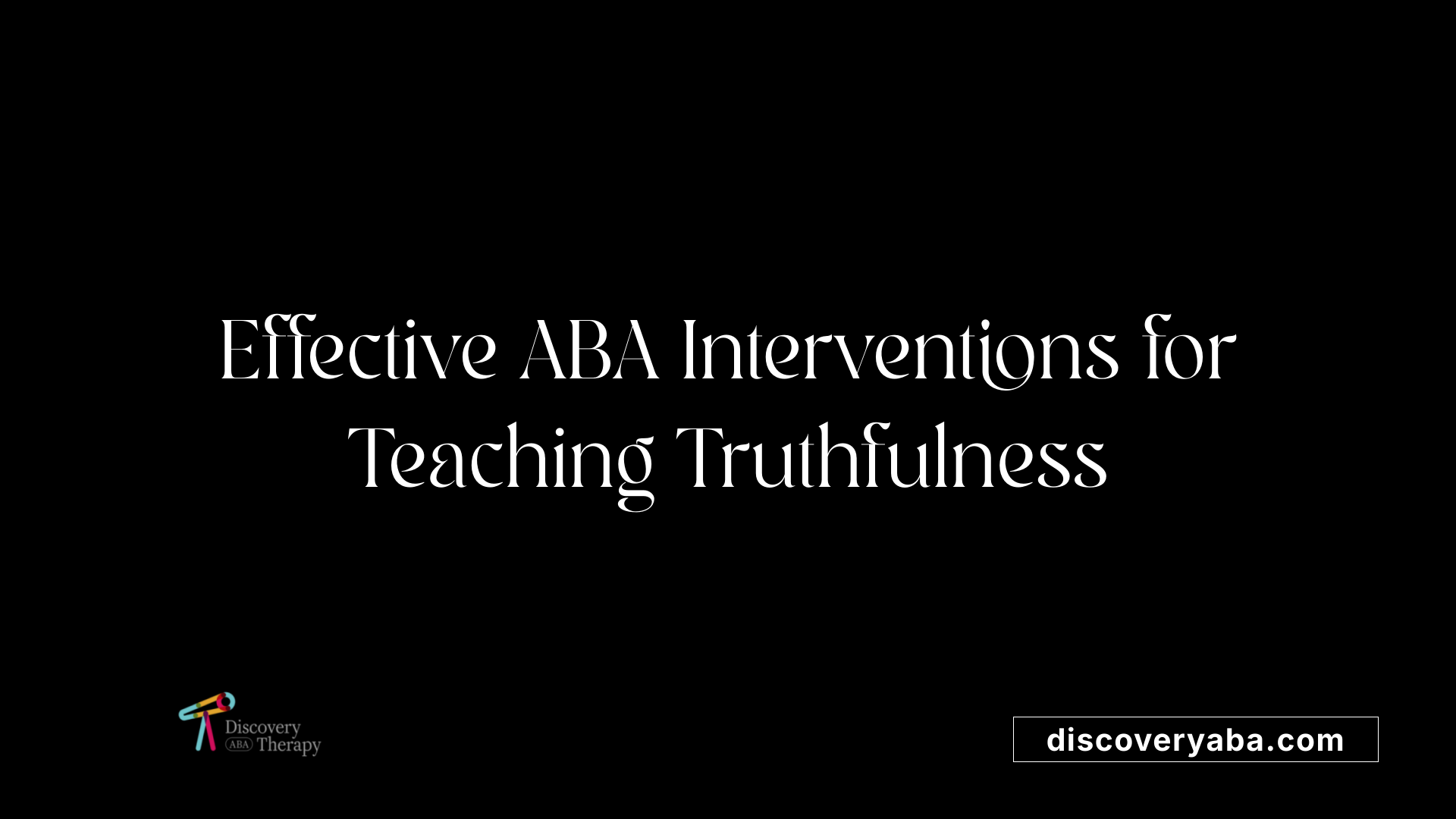Teaching honesty and truthfulness through ABA
Fostering Integrity: Modern Strategies for Teaching Honesty Through ABA

Building Trust and Truthfulness in Children and Individuals with Developmental Challenges
Teaching honesty and truthfulness is a critical component of social and emotional development, especially for children and individuals with developmental challenges such as autism spectrum disorder (ASD). Applied Behavior Analysis (ABA) offers proven, systematic approaches to foster these virtues through targeted interventions, reinforcing honest behaviors, and creating supportive environments. This article explores the research, strategies, and practical applications of ABA in promoting honesty, emphasizing ethical, respectful, and effective techniques.
Research Foundations and Effective Strategies in ABA for Honesty

What did research by Lehardy et al. (2022) reveal about increasing honesty in children with and without ASD?
Lehardy and colleagues conducted a study in 2022 that highlighted the effectiveness of Applied Behavior Analysis (ABA) techniques in promoting honesty among children, including those with Autism Spectrum Disorder (ASD). The study involved participants from both groups and demonstrated that specific ABA training protocols could successfully increase truthful reporting while reducing instances of rule-breaking or lying.
The researchers designed intervention environments that provided children with deliberate opportunities to lie or tell the truth. When children chose honesty, they were reinforced with positive consequences, which encouraged them to continue these behaviors. The findings provided strong evidence that ABA strategies can address dishonest behaviors early, which may help prevent more serious behavioral issues or trust problems later in life.
How does reinforcement training integrate opportunities for honesty?
In ABA-based training protocols for honesty, setting up opportunities where children can opt to lie or tell the truth is essential. Therapists and educators create situations that make honesty a viable and beneficial choice for children. For example, a child might be asked to report whether they completed a task or to tell the truth about an action they took.
When children demonstrate honesty, they often receive immediate positive reinforcement, such as praise, tokens, or preferred activities. This reinforcement not only increases the likelihood of honest reporting in the future but also helps children understand the value of truthfulness. Conversely, when children lie, the environment is structured to respond in a way that discourages dishonesty without resorting to punitive measures.
This approach emphasizes understanding the child's choices and using reinforcement contingencies to promote behaviors aligned with honesty.
What behavioral mechanisms influence honesty and lying?
Research indicates that several environmental and behavioral factors impact whether children report honestly. Punishments and reinforcements are particularly influential. When children are reinforced for honesty—such as through praise or rewards—they are more likely to report truthfully.
Additionally, the social context, such as the presence of an audience, can significantly influence honesty. Studies have shown that children tend to report more truthfully when they believe others are watching or when their reports are shared publicly, even if they do not receive immediate feedback.
Children’s past experiences with reinforcement for honesty or punishment for lying also shape their current reporting behavior. If honesty has been consistently rewarded and dishonesty has been met with consequences, children develop a pattern of truthful reporting across different settings.
How do environmental variables like audience presence impact honesty?
The presence of an audience can serve as a social reinforcement that encourages children to report more truthfully. Research findings suggest that children are more likely to admit mistakes or tell the truth when they know others are listening or observing.
This effect occurs because children are motivated by social approval and a desire to maintain a positive image. Interestingly, this increased honesty can happen even without immediate feedback or consequences, highlighting the power of social context.
How does understanding intention help explain lying behavior?
Behavior analysts interpret lying as a form of verbal behavior influenced by environmental consequences, including reinforcement and modeling. They consider a child's intention—whether they are trying to avoid punishment, gain attention, or seek approval—as a critical factor.
Understanding these intentions allows therapists and educators to tailor interventions that address the underlying motivations behind dishonest behaviors, rather than simply punishing the act itself. This perspective emphasizes supportive environments where honesty is nurtured through positive reinforcement and clear expectations.
What teaching methods are used to promote honesty in classrooms?
Educational programs incorporate several strategies to teach honesty effectively. These include the use of social stories—stories that depict honest behavior in relatable scenarios—at various levels to reinforce the importance of truthfulness.
Direct instruction and discussion questions help children understand the value of honesty. Interactive activities like role-playing or games such as "The Truth Tree" or "I Spy" make learning about honesty engaging and practical.
Classroom resources often include visual aids like posters and review pages to remind children of honest behaviors. School curricula may also involve family resources such as newsletters and social stories that promote the generalization of honesty beyond the classroom.
What are the traits of modern, respectful ABA approaches?
Contemporary ABA emphasizes positive reinforcement over punitive methods. Modern therapy focuses on building communication, social skills, and independence rather than suppressing undesirable behaviors.
These approaches are flexible, personalized, and rooted in collaboration and respect for the individual. They often involve play-based, child-led activities within natural environments, fostering motivation and engagement.
How does naturalistic ABA support teaching honesty?
Naturalistic Behavioral Interventions (NDBI) embed learning opportunities into daily routines and activities that children find motivating. These methods are designed to empower children, supporting their self-expression and emotional needs.
By creating a child-driven and motivation-based learning environment, naturalistic ABA nurtures honesty by fostering trust and autonomy, making it easier for children to grasp the importance of truthful interactions.
What overarching goals does ABA pursue regarding honesty?
The main objective of ABA in teaching honesty is to develop meaningful life skills that promote independence and positive social interactions. It aims to teach children the value of trustworthiness and honesty within their personal and social lives.
ABA programs are highly individualized, with ongoing assessment and data collection ensuring that interventions adapt to each child's needs and progress. The emphasis remains on supporting children to become honest, confident, and capable individuals.
| Aspect | Description | Impact on Honesty Development |
|---|---|---|
| Reinforcement | Use of praise, tokens, and privileges | Encourages truthful reporting |
| Audience presence | Watching and sharing feedback | Increases honesty through social motivation |
| Social stories | Teaching through relatable narratives | Reinforces honest behavior |
| Naturalistic methods | Child-led and embedded in daily routines | Promotes autonomy and trust |
| Modern ABA focus | Positive, collaborative, individualized | Supports genuine understanding and internalization of honesty principles |
This comprehensive approach integrates research evidence, behavioral insights, and engaging teaching strategies to foster honesty in children, including those with developmental challenges, using modern, respectful ABA methods.
Practical Strategies for Educators and Therapists Using ABA

What are practical strategies for educators and therapists when promoting honesty using ABA?
Applying Applied Behavior Analysis (ABA) to teach honesty involves a combination of consistent implementation and tailored approaches. Ensuring high treatment fidelity is fundamental. This means adhering strictly to reinforcement schedules and prompts designed to motivate honest responses. Regular training sessions and supervision help staff stay aligned with intervention protocols, preventing drift and maintaining effectiveness.
Incorporating visual supports can greatly enhance understanding. Visual cues like charts or symbols remind children about honest behavior and reinforce expectations in different settings. Social stories, which narrate situations involving honesty, help children grasp the importance of truthfulness and understand how to behave in specific contexts.
Role-playing situations where children practice telling the truth allows them to rehearse honest responses in a safe, controlled environment. These activities can be embedded within daily routines to promote generalization.
Family involvement plays a crucial role in sustaining progress. Educators and therapists should work closely with families, providing resources like newsletters or social stories to reinforce concepts at home. Regular progress tracking through data collection helps professionals adapt strategies to individual needs.
Collaboration among team members—including clinicians, teachers, and family members—is essential. Consistent communication ensures that strategies are applied uniformly across environments, facilitating meaningful behavioral change.
Ultimately, successful promotion of honesty through ABA relies on diligent, consistent implementation combined with engaging, child-centered teaching techniques. This approach helps children internalize truthful behaviors that can last a lifetime, supporting their social and emotional development.
Behavioral Interventions and Techniques for Teaching Truthfulness

What are ABA interventions for teaching honesty and truthfulness?
Behavioral interventions based on Applied Behavior Analysis (ABA) are highly effective in promoting honesty and reducing rule-breaking among children. These interventions often involve setting up structured scenarios where children have opportunities to tell the truth in exchange for access to preferred items or activities. For instance, a child might be given the chance to earn a toy by honestly reporting whether they completed a task or engaged in a transgression.
Central to this approach are reinforcement strategies that positively encourage honest responses. When a child reports truthfully, they receive reinforcement, such as praise or access to desired items. Conversely, if a child lies, they may face gentle sanctions or be guided to understand the importance of honesty. This balance helps children learn that truthfulness leads to positive consequences.
Research by Lehardy et al. (2022) underscores the effectiveness of these methods. Their study involved children with and without Autism Spectrum Disorder (ASD), showing that structured and reinforcement-based training successfully increased honesty and decreased rule-breaking behaviors.
Modeling truth-telling behavior is also a key component. Therapists and teachers demonstrate honesty through social stories and direct examples, making the concept clear and relatable for children. Social stories are especially useful—they can portray honest behavior at different levels to reinforce understanding and acceptance.
In addition to reinforcement and modeling, incorporating principles from Trauma-Informed Behavioral Interventions (TBRI®) enhances the effectiveness of ABA. TBRI® emphasizes creating a safe, nurturing environment and understanding each child's motivation. By validating feelings and addressing underlying emotional needs, children become more receptive to learning honest behavior.
Furthermore, understanding that lying is a verbal behavior influenced by external contingencies helps guide these interventions. For example, children are more likely to report truthfully when they feel safe and valued, and when their reporting is linked to positive outcomes.
In practical settings, strategies include using classroom activities such as interactive discussions, review pages, and story-based learning to embed honesty into daily routines. For example, teachers might use books like 'Lying Up A Storm' by Julia Cook to extend lessons about honesty beyond the classroom.
Overall, ABA interventions for promoting honesty emphasize positive reinforcement, modeling, safe environments, and understanding motivation. These techniques foster not only immediate behavior change but also lay the foundation for long-term honesty and integrity.
Educational and Therapeutic Programs Promoting Honesty via ABA

Are there educational or therapeutic programs that promote honesty using ABA?
Yes, many programs incorporate Applied Behavior Analysis (ABA) techniques to teach honesty and reduce rule-breaking. These programs are designed to help children develop truthful behaviors within supportive learning environments.
One common strategy involves the use of social stories—narrative tools at various levels that explicitly teach children about honesty and the importance of truthfulness. For example, social stories describe scenarios where honesty is reinforced and modeled, helping children understand why telling the truth matters.
Positive reinforcement plays a significant role. Children are rewarded for honest responses, which encourages them to repeat truthful behavior. This reinforcement can be delivered immediately after honest reporting through praise, tokens, or other preferred items, creating strong contingencies that promote honesty.
Role-playing exercises are also employed to simulate real-life situations where children might face temptations to lie. These activities allow children to practice honest responses in a safe and controlled setting, increasing their confidence and likelihood of truthful behavior in everyday life.
Studies, such as one by Lehardy et al. (2022), have shown that these ABA methods effectively increase honesty and decrease rule violations in children with and without Autism Spectrum Disorder. The programs are tailored to each child's needs, employing engaging, play-based methods that respect individual differences.
Why is high treatment fidelity, family participation, and collaboration important?
Ensuring high treatment fidelity—that is, consistent and accurate implementation of ABA protocols—is essential for achieving lasting behavior change. Well-trained therapists and caregivers follow structured plans, which include social stories, reinforcement schedules, and role-playing activities.
Family participation enhances generalization, or the transfer of learned skills across different settings. When families are involved through newsletters, social stories, and guidance, children can practice honesty at home, school, and community environments.
Collaboration between therapists, teachers, and families ensures that strategies are aligned and reinforced across all contexts. This integrated approach maximizes the chances that honesty becomes a habitual behavior, not just limited to therapy sessions.
What does a comprehensive ABA-based honesty curriculum include?
An effective curriculum combines various methods and tools. It typically involves structured lesson plans, classroom posters reminding students about honesty, and interactive notebooks where children record their progress.
Assessment tools are used regularly to track improvements and identify areas needing additional support. These include behavior charts, checklists, and data collection forms that help therapists and educators measure changes over time.
To promote generalization, curricula incorporate family resources such as newsletters and social stories that reinforce honesty outside the classroom environment. Additionally, literature like Julia Cook’s
Understanding Behavioral and Neural Mechanisms Influencing Honesty
How can behavioral mechanisms influence honesty and lying?
Behavioral factors play a significant role in shaping honest and dishonest behaviors. Reinforcement, both positive and negative, can encourage children to tell the truth. For example, providing praise or rewards for honesty strengthens the likelihood of truthful responses. Modeling also has a strong influence; children observing honest behaviors in peers or adults tend to imitate these actions. Creating an environment where honesty is valued and rewarded helps establish social norms that promote truthful behavior.
External contingencies like reinforcement or punishment directly impact whether a child is more likely to lie or tell the truth. Techniques from Applied Behavior Analysis (ABA) emphasize positive reinforcement to foster honesty. Modern ABA programs incorporate engaging, play-based activities, social stories, and classroom posters to teach, reinforce, and generalize truth-telling behaviors. These methods focus on building communication skills and moral understanding without resorting to punitive measures.
Research with neuroimaging tools has advanced understanding of the cognitive processes involved in deception. Activation in prefrontal brain regions, such as the dorsolateral prefrontal cortex and anterior cingulate cortex, is observed during deception tasks. These areas are associated with cognitive control, conflict monitoring, and emotional regulation, indicating that lying is mentally demanding and often involves managing emotional responses.
Damage or dysfunction in these neural regions can impair honesty, revealing how critical these brain areas are for self-control and decision-making related to truthfulness. Understanding these neural pathways helps clarify why some individuals may find it harder to tell the truth in certain situations, especially when stakes are high or social image is concerned.
Behavioral signaling frameworks help explain how mental representations, beliefs, and value judgments influence honesty. These models show that individuals weigh the potential social, emotional, and personal consequences of lying or truth-telling, which influences their choices.
What is the impact of social norms and perceptions on honesty?
Social norms and perceptions greatly influence whether individuals are honest. Concerns about social image or fear of judgment can either encourage or inhibit truthful behavior. When children perceive that honesty aligns with social expectations, they are more likely to tell the truth. Conversely, the presence of an audience or the perceived scrutiny of others can increase honest reporting, as documented in research showing children are more truthful when observed.
Strategies such as social stories, classroom discussions, and community reinforcement help embed honesty into social expectations. These methods leverage social norms to promote pro-social behavior. For instance, social stories at different developmental levels teach children about honesty, emphasizing its value and importance in society.
In summary, behavioral mechanisms such as reinforcement and modeling, combined with neural activity in brain regions responsible for cognitive control, and social perceptions, all collaboratively shape honesty and lying behaviors. A comprehensive understanding of these factors supports the development of effective interventions and educational practices to promote truthfulness across various settings.
Promoting Honesty with Compassion and Consistency
Incorporating ABA strategies to teach honesty and truthfulness is a promising and effective approach that respects individual differences and promotes lasting behavioral change. Emphasizing positive reinforcement, modeling, and real-life practice helps children and individuals with developmental challenges develop integrity within a supportive environment. Collaboration among educators, therapists, and families ensures consistency and generalization, fostering a foundation of trust and ethical decision-making. As research advances, integrating behavioral insights with compassionate, respectful practices will continue to enhance the effectiveness of teaching honesty through ABA, ultimately supporting individuals in building meaningful, truthful relationships that serve as a bedrock for social success.
References
- Don't Lie to Me! - ABLE | ABA Autism Therapy
- The Truth About Lying: A Behavioral Perspective
- I Will Tell the Truth: Behavior Basics - Autism Adventures
- Common Myths About ABA Therapy and the Truth Behind Them
- Does ABA Therapy Force Children to Comply? The Truth About ...
- 7 Common Myths About ABA Therapy — And The Truth behind them.
- Treatment Integrity in ABA: Ensuring Everyone's Doing It Right
Does Your Child Have An Autism Diagnosis?
Learn More About How ABA Therapy Can Help
Find More Articles
Contact us
North Carolina, Nevada, Utah, Virginia
New Hampshire, Maine
Arizona, Colorado, Georgia, New Mexico, Oklahoma, Texas
.avif)




































































































